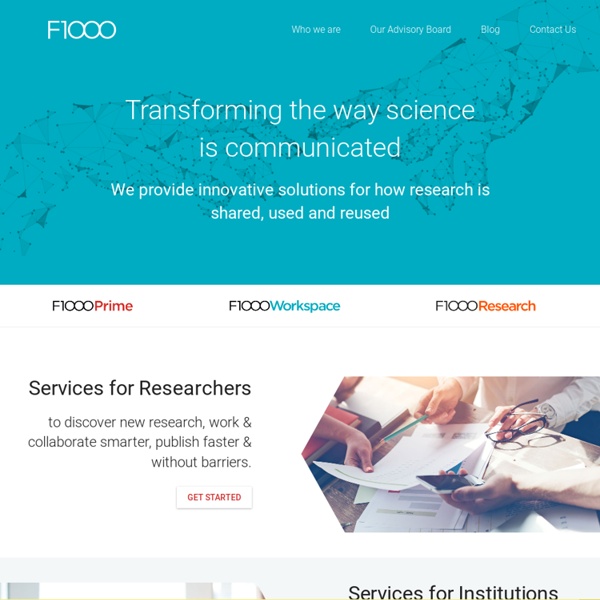



Interdisciplines Copy/paste this URL to link to this paper The concept of homophily [2] describes relationships that are based on some measures of similarity or closeness. Despite the fact that no single definition exists for similarity, in the scope of this work, we consider two types of relationships to define similarity: citation and co-authorship. Using these relationships, we can measure similarity to be inversely proportional to the distance that separates researchers in the co-authorship network and papers in the citation network [3]. Free conservation biology textbook: Conservation Biology for All Oxford University Press makes conservation biology textbook by some of the world's most prominent ecologists and conservation biologists available as free download Conservation Biology for All provides cutting-edge but basic conservation science to a global readership. A series of authoritative chapters have been written by the top names in conservation biology with the principal aim of disseminating cutting-edge conservation knowledge as widely as possible. Important topics such as balancing conversion and human needs, climate change, conservation planning, designing and analyzing conservation research, ecosystem services, endangered species management, extinctions, fire, habitat loss, and invasive species are covered. Numerous text boxes describing additional relevant material or case studies are also included.
CODEX Alimentarius: Home CXS 193-1995General Standard for Contaminants and Toxins in Food and Feed CXC 1-1969General Principles of Food Hygiene CXS 1-1985General Standard for the Labelling of Prepackaged Foods CXG 2-1985Guidelines on Nutrition Labelling CXM 2Maximum Residue Limits (MRLs) and Risk Management Recommendations (RMRs) for Residues of Veterinary Drugs in Foods University of Trento - Italy - UNITN-Eprints - Reviewing peer review: a quantitative analysis of peer review Casati, Fabio and Marchese, Maurizio and Mirylenka, Katsiaryna and Ragone, Azzurra (2010) Reviewing peer review: a quantitative analysis of peer review. UNSPECIFIED. (Unpublished) In this paper we focus on the analysis of peer reviews and reviewers behavior in a number of different review processes. More specifically, we report on the development, definition and rationale of a theoretical model for peer review processes to support the identification of appropriate metrics to assess the processes main properties.
Evolution: Education and Outreach - Free Access Available As of January 2013 Evolution: Education & Outreach is a peer-reviewed open access journal published under the brand SpringerOpen. From 2013 onward all new articles published in the journal are freely and permanently available online for anyone, anywhere and at any time. This journal promotes accurate understanding and comprehensive teaching of evolutionary theory for a wide audience. Evolution: Education and Outreach addresses the question of why we should care about evolution by exploring the practical applications of evolutionary principles in daily life and the impact of evolutionary theory on culture and society throughout history.
Research Evaluation — LiquidPub Project Documents Reviewing peer review: a quantitative analysis of peer review Fabio Casati, Maurizio Marchese, Katsiaryna Mirylenka, Azzurra Ragone In this paper we focus on the analysis of peer reviews and reviewers behavior in a number of different review processes. An Error Occurred Setting Your User Cookie This site uses cookies to improve performance. If your browser does not accept cookies, you cannot view this site. Setting Your Browser to Accept Cookies There are many reasons why a cookie could not be set correctly. Below are the most common reasons: You have cookies disabled in your browser. Is liquid publication and peer review the wave of the future in science? As a professor and researcher, one of my most time-consuming tasks is performing peer review. That is, reading and commenting on articles submitted to conferences and journals, proposals submitted to granting agencies, theses submitted for degrees, and promotion dossiers (which themselves require reading several papers). In this post I will point out the strengths and weaknesses of the current peer review systems, as I see them, and make some suggestions for change. The suggestions include adopting what is called liquid publication in parallel with the classic gate-keeping style of peer review. Liquid publication focuses on post-publication review and citation; blogs are one form of this.
Timeline: The evolution of life - life - 14 July 2009 Read full article Continue reading page |1|2|3|4 There are all sorts of ways to reconstruct the history of life on Earth. Liquid Publications A possible alternative to Peer Review and the ‘publish or perish’ logic of academic publishing URL = “In a nutshell, the approach proposes the following ideas and contributions: 1. It introduces the notion of Liquid Publications (and, analogously, Liquid Textbooks) as evolutionary, collaborative, multi-faceted knowledge objects that can be composed and consumed at different levels of detail. 2.